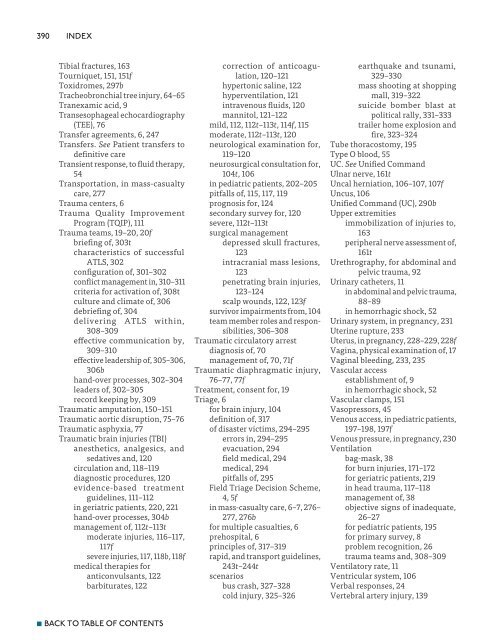Advanced Trauma Life Support ATLS Student Course Manual 2018
You also want an ePaper? Increase the reach of your titles
YUMPU automatically turns print PDFs into web optimized ePapers that Google loves.
390<br />
INDEX<br />
Tibial fractures, 163<br />
Tourniquet, 151, 151f<br />
Toxidromes, 297b<br />
Tracheobronchial tree injury, 64–65<br />
Tranexamic acid, 9<br />
Transesophageal echocardiography<br />
(TEE), 76<br />
Transfer agreements, 6, 247<br />
Transfers. See Patient transfers to<br />
definitive care<br />
Transient response, to fluid therapy,<br />
54<br />
Transportation, in mass-casualty<br />
care, 277<br />
<strong>Trauma</strong> centers, 6<br />
<strong>Trauma</strong> Quality Improvement<br />
Program (TQIP), 111<br />
<strong>Trauma</strong> teams, 19–20, 20f<br />
briefing of, 303t<br />
characteristics of successful<br />
<strong>ATLS</strong>, 302<br />
configuration of, 301–302<br />
conflict management in, 310–311<br />
criteria for activation of, 308t<br />
culture and climate of, 306<br />
debriefing of, 304<br />
delivering <strong>ATLS</strong> within,<br />
308–309<br />
effective communication by,<br />
309–310<br />
effective leadership of, 305–306,<br />
306b<br />
hand-over processes, 302–304<br />
leaders of, 302–305<br />
record keeping by, 309<br />
<strong>Trauma</strong>tic amputation, 150–151<br />
<strong>Trauma</strong>tic aortic disruption, 75–76<br />
<strong>Trauma</strong>tic asphyxia, 77<br />
<strong>Trauma</strong>tic brain injuries (TBI)<br />
anesthetics, analgesics, and<br />
sedatives and, 120<br />
circulation and, 118–119<br />
diagnostic procedures, 120<br />
evidence-based treatment<br />
guidelines, 111–112<br />
in geriatric patients, 220, 221<br />
hand-over processes, 304b<br />
management of, 112t–113t<br />
moderate injuries, 116–117,<br />
117f<br />
severe injuries, 117, 118b, 118f<br />
medical therapies for<br />
anticonvulsants, 122<br />
barbiturates, 122<br />
correction of anticoagulation,<br />
120–121<br />
hypertonic saline, 122<br />
hyperventilation, 121<br />
intravenous fluids, 120<br />
mannitol, 121–122<br />
mild, 112, 112t–113t, 114f, 115<br />
moderate, 112t–113t, 120<br />
neurological examination for,<br />
119–120<br />
neurosurgical consultation for,<br />
104t, 106<br />
in pediatric patients, 202–205<br />
pitfalls of, 115, 117, 119<br />
prognosis for, 124<br />
secondary survey for, 120<br />
severe, 112t–113t<br />
surgical management<br />
depressed skull fractures,<br />
123<br />
intracranial mass lesions,<br />
123<br />
penetrating brain injuries,<br />
123–124<br />
scalp wounds, 122, 123f<br />
survivor impairments from, 104<br />
team member roles and responsibilities,<br />
306–308<br />
<strong>Trauma</strong>tic circulatory arrest<br />
diagnosis of, 70<br />
management of, 70, 71f<br />
<strong>Trauma</strong>tic diaphragmatic injury,<br />
76–77, 77f<br />
Treatment, consent for, 19<br />
Triage, 6<br />
for brain injury, 104<br />
definition of, 317<br />
of disaster victims, 294–295<br />
errors in, 294–295<br />
evacuation, 294<br />
field medical, 294<br />
medical, 294<br />
pitfalls of, 295<br />
Field Triage Decision Scheme,<br />
4, 5f<br />
in mass-casualty care, 6–7, 276–<br />
277, 276b<br />
for multiple casualties, 6<br />
prehospital, 6<br />
principles of, 317–319<br />
rapid, and transport guidelines,<br />
243t–244t<br />
scenarios<br />
bus crash, 327–328<br />
cold injury, 325–326<br />
earthquake and tsunami,<br />
329–330<br />
mass shooting at shopping<br />
mall, 319–322<br />
suicide bomber blast at<br />
political rally, 331–333<br />
trailer home explosion and<br />
fire, 323–324<br />
Tube thoracostomy, 195<br />
Type O blood, 55<br />
UC. See Unified Command<br />
Ulnar nerve, 161t<br />
Uncal herniation, 106–107, 107f<br />
Uncus, 106<br />
Unified Command (UC), 290b<br />
Upper extremities<br />
immobilization of injuries to,<br />
163<br />
peripheral nerve assessment of,<br />
161t<br />
Urethrography, for abdominal and<br />
pelvic trauma, 92<br />
Urinary catheters, 11<br />
in abdominal and pelvic trauma,<br />
88–89<br />
in hemorrhagic shock, 52<br />
Urinary system, in pregnancy, 231<br />
Uterine rupture, 233<br />
Uterus, in pregnancy, 228–229, 228f<br />
Vagina, physical examination of, 17<br />
Vaginal bleeding, 233, 235<br />
Vascular access<br />
establishment of, 9<br />
in hemorrhagic shock, 52<br />
Vascular clamps, 151<br />
Vasopressors, 45<br />
Venous access, in pediatric patients,<br />
197–198, 197f<br />
Venous pressure, in pregnancy, 230<br />
Ventilation<br />
bag-mask, 38<br />
for burn injuries, 171–172<br />
for geriatric patients, 219<br />
in head trauma, 117–118<br />
management of, 38<br />
objective signs of inadequate,<br />
26–27<br />
for pediatric patients, 195<br />
for primary survey, 8<br />
problem recognition, 26<br />
trauma teams and, 308–309<br />
Ventilatory rate, 11<br />
Ventricular system, 106<br />
Verbal responses, 24<br />
Vertebral artery injury, 139<br />
n BACK TO TABLE OF CONTENTS

















